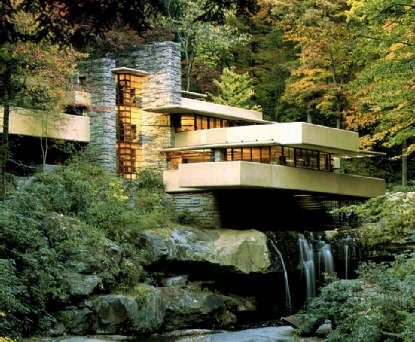
The architect Frank Lloyd Wright designed Fallingwater (1934–1937) for the Pittsburgh department store owner Edgar J. Kaufmann and his wife Liliane, on Bear Run, Pennsylvania, in the mountains southeast of Pittsburgh. The spectacular house cantilevers over a 20-foot (6-meter) waterfall amidst a wilderness. Widely admired for over sixty years, Fallingwater has been called “the most famous residence ever built”; in 1991 the American Institute of Architects hailed it as “the best all-time work of American architecture.” It is probably the most beautiful house of the twentieth century, some say of any century. Bear Run Nature Reserve, the 5,000-acre (2,000-hectare) area surrounding Fallingwater, and the house itself are now owned, maintained, and protected by the Western Pennsylvania Conservancy.
Throughout the 1920s and well into the next decade, Wright had little work. He publicized himself through writing and a traveling exhibition (he called it “The Show”) in the United States and Europe, but despite the efforts of his friends, his poor financial management put him deeply in debt. In 1932 he established the Taliesin Fellowship in Wisconsin, a residential apprentice system in which aspiring artists and architects paid for the privilege of working for him.
Among them was Edgar J. Kaufmann Jr. Impressed with what he saw during a 1934 visit to Wright’s Wisconsin home, Taliesin, and by his son’s enthusiasm, Kaufmann Sr. commissioned Wright, who was then sixty-five years old, to design a mountain retreat for his family. The waterfall on Bear Run was a favorite spot of the Kaufmanns’, and they wanted to build nearby. There is a tradition that Wright made the final design after only one visit to the site: the surprising idea, accepted by his clients, was that the house should sit over rather than face the waterfall.
Fallingwater’s four levels are progressively set back to lie low against the forested hillside; their terraces, apparently suspended in space, echo the form of the waterfall. Wright built the house around a core containing a kitchen on the lowest level and bedrooms on the others; it also housed the service ducts. The house’s horizontality—Wright called it the line of domesticity—is juxtaposed against a four-story sand-stone chimney. The lowest floor, a huge living room, is carried on four stub walls and provides the widest views of the site; one of its cantilevered terraces faces upstream; the other projects over the great boulders framing the waterfall. From the living room, a short flight of stairs leads to a platform just above the creek. It serves little practical purpose, but in summer air from the running water cools the space above. The bedrooms on the second level each have a narrower terrace, and the rooms—another bedroom and a study—on the third level also open to a terrace. Wright used the stairs, terraces, and windows (full height on three sides of the living room) to integrate exterior and interior, house and site. Architectural historian Spiro Kostof comments that Wright “sends out free-floating platforms audaciously over a small waterfall and anchors them in the natural rock. Something of the prairie house is here still…. But the house is thoroughly fused with its site and, inside, the rough stone walls and the flagged floors are of an elemental ruggedness” (Kostof 1985, 737).
All of Fallingwater’s vertical elements—walls, fireplace, chimney—are built of sandstone quarried on the site and laid in shallow, regular courses by local craftsmen. The cantilevered, horizontal elements—floor slabs and edge beams, roofs and ceilings—are constructed of in situ reinforced concrete and painted with a sand-textured, warm-buff paint. Setting aside the misgivings of some structural engineers that the daring cantilevers would fail, Wright exploited the reinforced concrete, a material with which he had worked since 1904. When the contractor hesitated to remove the formwork supports of the main floor slab. Wright insisted that they be struck. The floor did not collapse. The slab deflected more than was expected, and the upper terrace followed because they were tied together, but the ensuing cracks did not threaten structural stability.
The interior floors are paved with randomly shaped flags of sandstone, waxed and polished to give a wet appearance, forming yet another link with the site. The beautifully crafted joinery is of sap-grain walnut, and the windows have steel frames painted Cherokee red. There is a separate guest wing farther up the hillside, reached by a path with a stepped, vaulted canopy that circles a large oak tree. The house was completed in 1937 at a cost of almost $155,000—four times the original estimate.
In the face of what Henry-Russell Hitchcock and Philip Johnson dubbed the International Style and the 1930s immigration of many of its greatest proponents to the United States, Wright, when many critics believed his energy was spent, entered a new twenty-five-year phase of his career with Fallingwater. The house employed the same technologies as the “glass boxes on stilts” then fashionable on both sides of the Atlantic, while challenging their bland esthetic.
No comments:
Post a Comment